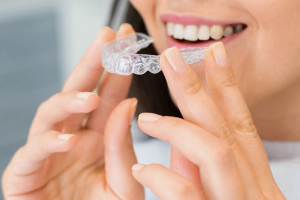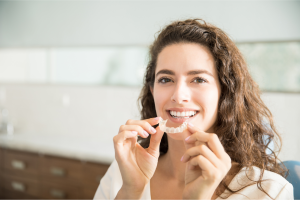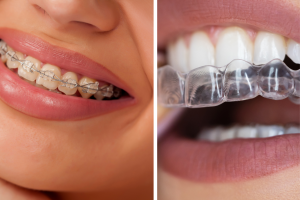For many people in the UK, an attractive smile is associated with straight, well‑aligned teeth. Parents often wonder when to start orthodontic treatment for children, while adults may consider correcting crowded or crooked teeth later in life. A common question is whether braces or clear aligners will permanently fix tooth alignment.
This blog explores how modern orthodontics works, what affects long‑term stability, and why clear aligners are an appealing option for many patients. As always, seek personalised advice from a qualified dentist or orthodontist before starting treatment.
How Teeth Move and What Braces Do
Orthodontic appliances such as metal braces or clear aligners apply gentle, continuous forces to teeth. These forces stimulate the periodontal ligament and bone around the tooth, causing bone resorption on one side and formation on the other. Over time, teeth move into a new position.
The British Orthodontic Society (BOS) notes that most children begin treatment around ages 12–13 once the permanent teeth have erupted, but age is not a barrier; adults can also have their teeth straightened if gums and teeth are healthy. The ideal timing depends on individual growth patterns and dental issues; serious cases may warrant earlier intervention around age 7–8.
Traditional braces consist of brackets bonded to the teeth and connected by wires. The wires are periodically tightened, which gradually moves teeth into alignment. Braces are effective for complex malocclusions and can correct rotation, crowding and bite problems. Treatment duration varies from 18 to 36 months in many cases. Clear aligners, such as Invisalign, use a series of custom‑made trays that are changed every one to two weeks.
Each aligner exerts a small force, gradually guiding teeth into the desired position. Aligners are best for mild to moderate cases and require disciplined wear of 20–22 hours per day. They are nearly invisible, removable for meals and cleaning, and typically need fewer dental visits. For many adults who prefer discreet treatment, aligners offer an attractive alternative.
Can Braces Permanently Fix Tooth Alignment?
Braces can produce dramatic improvements, but claiming that they permanently fix tooth alignment without ongoing care is misleading. Teeth are anchored by periodontal ligaments and bone, and they continue to respond to forces throughout life. The BOS highlights that one of the most common problems after treatment is relapse, where teeth gradually return toward their original positions.
During treatment, ligaments and soft tissues adapt to the new arrangement. Once braces are removed, those tissues can exert pressure that encourages teeth to drift back. Ageing, genetics and habits such as clenching or grinding can also shift teeth over time. Even people who have never had orthodontic treatment may notice that their teeth become more crowded with age.
Because of these biological realities, orthodontists use retainers after active treatment. Retainers hold teeth in their new alignment while the surrounding bone and tissues stabilise. Several credible sources emphasise that wearing a retainer is essential for long‑term success.
The NHS notes that retainers should be worn as advised because there will be some tooth movement if you stop wearing them, and the only way to have permanently straight teeth is to keep using a retainer.
The BOS explains that the longer you wear retainers, the longer you can keep teeth straight; as we get older, teeth can move unpredictably and show increased crowding. In other words, braces or aligners can align teeth, but retention is the key to maintaining the result.
Types of Retainers and How Long to Wear Them
Orthodontists prescribe different types of retainers depending on the situation. Removable retainers include vacuum‑formed clear retainers and Hawley retainers, which are worn over the teeth at night.
Fixed retainers involve a thin wire bonded behind the front teeth. Straight Teeth Direct, an online aligner provider, notes that a fixed retainer alone may not hold all teeth, particularly if arch expansion has occurred; a removable retainer is often added for comprehensive retention. The BOS lists clear vacuum‑formed retainers, bonded wires and Hawley appliances as common options.
The recommended wear schedule depends on the stage of treatment. Moray Orthodontics advises patients to wear a retainer full‑time for the first 3–6 months, then nightly for the next 6 months to a year, and eventually a few nights per week indefinitely.
Straight Teeth Direct suggests constant wear for the first 2–4 weeks, then night‑time wear, gradually reducing to a few nights per week over time. The overarching message is that some retainer use is usually needed for life. Long‑term maintenance prevents subtle changes from undoing the hard work of braces or aligners, and occasional wear can preserve results indefinitely.
Potential Side Effects and Risks of Braces
As with any medical procedure, orthodontic treatment carries risks. The BOS’s guidance on risks of orthodontic treatment notes common adverse effects such as pain or discomfort, gum inflammation, small areas of root resorption (shortening) and increased risk of dental decay if oral hygiene is poor.
Root resorption is often mild but can be exacerbated by high forces or long treatment times. Additionally, teeth may move again after treatment; the BOS cautions that tooth movement will occur, and retainers are needed to prevent relapse.
An article from Whites Dental, a London practice, adds that braces can cause pain (reported by 70–95 % of patients), gum and bone damage due to difficulty cleaning around braces, decalcification (white spot lesions) and increased risk of cavities.
Rarely, braces can damage the tooth pulp or trigger temporomandibular joint issues if the bite is incorrectly altered. Working with an experienced orthodontist and maintaining excellent oral hygiene reduces these risks. Patients must be informed of potential adverse effects before consenting to treatment.
Clear aligners share some of these risks but avoid others. They are removable, allowing normal brushing and flossing, which reduces the risk of decalcification and cavities.
Because they lack brackets and wires, aligners generally cause less irritation to cheeks and lips, resulting in greater comfort. However, aligners require self‑discipline; failing to wear them the recommended 20–22 hours per day may lengthen treatment or compromise results.
Comparing Braces and Clear Aligners: Which Is Right for You?
Both braces and clear aligners can straighten teeth, but they offer different experiences. Understanding these differences helps you make an informed decision.
Visibility and Aesthetics: Traditional metal braces are highly visible, which can affect self‑confidence. Ceramic braces are less conspicuous but still noticeable. Clear aligners, on the other hand, are virtually invisible and suit adults or teenagers who prefer a discreet option.
Comfort and Oral Hygiene: Braces use brackets and wires that may irritate the soft tissues and require extra care when brushing and flossing. Aligners are smooth and removable, so patients can eat normally and clean their teeth without special tools. Removability also means there are no dietary restrictions with aligners, whereas brace wearers must avoid hard or sticky foods that could break brackets.
Treatment Time and Suitability: Braces are versatile and can handle severe crowding, complex bite issues and rotated teeth. For such cases, braces may be the only viable option. Aligners are effective for mild to moderate misalignments and typically deliver results faster; some cases finish in 6–18 months compared with 18–36 months for braces. Dr Rez Dental points out that aligners can reduce the number of dental visits since many sets are delivered upfront. However, success depends on wearing aligners consistently.
Costs and Appointments: The cost of orthodontic treatment varies depending on complexity and location. Clear aligners may be slightly more expensive than metal braces, but the convenience and aesthetic benefits often justify the price for adults. Aligners also reduce the need for emergency appointments due to broken brackets or poking wires. For those working or attending school, fewer visits can mean less disruption to daily life.
Age‑Specific Considerations for Orthodontic Treatment in the UK
Children and Teenagers
Orthodontists evaluate children’s bite and jaw growth during regular dental check‑ups. According to the BOS, many children begin treatment around ages 12–13 when most permanent teeth have erupted.
Some issues, like severe crossbites or jaw discrepancies, may require intervention as early as age 7 or 8. Starting treatment during adolescence can take advantage of growth spurts, making it easier to guide jaw development and shorten treatment time. Adolescence is also a period when peers undergo similar orthodontic treatment, which can reduce self‑consciousness.
Parents should watch for signs such as difficulty biting, crowded teeth, mouth breathing or speech issues. Early evaluation does not always mean immediate braces; sometimes, monitoring is sufficient until the optimal time for treatment.
Remember that many teenagers value aesthetics; clear aligners may provide an attractive and comfortable option if recommended by the orthodontist and if the patient is disciplined enough to wear them as instructed.
Adults
Many adults assume that orthodontics is only for children, but healthy teeth can be moved at any age. The BOS emphasises that age is not a barrier to treatment. Adult orthodontics is growing in popularity, particularly with clear aligners.
Adults may seek treatment for aesthetic reasons, to correct shifting teeth or to improve oral health before restorative work. Aligners are particularly appealing because they fit into professional and social lifestyles: they are discrete, removable and comfortable. However, adults should be aware that age‑related bone changes can make tooth movement slightly slower, and retention is just as important to prevent relapse.
Clear Aligners: Promoting a Modern Solution
Clear aligners have revolutionised orthodontic care, offering a modern alternative to braces. Key benefits include:
- Discreet appearance: Aligners are nearly invisible, making them ideal for self‑conscious teenagers or professionals.
- Flexibility: You can remove aligners for meals and special occasions. There are no dietary restrictions and no risk of emergency visits for broken brackets.
- Oral hygiene: Because aligners are removable, brushing and flossing remain unchanged. This decreases the risk of cavities and gum disease during treatment.
- Comfort: The smooth plastic trays lack wires and brackets, reducing mouth sores and discomfort.
- Efficiency: For non‑complex cases, aligners may straighten teeth faster than traditional braces. They require fewer in‑person visits, fitting busy lifestyles.
However, aligners require commitment. Patients must wear each tray for 20–22 hours daily and change trays as instructed. Failure to do so may delay results or necessitate refinements. Aligners might not be suitable for very complex corrections; a professional assessment is essential to determine candidacy. Some patients still prefer braces for severe malocclusions or because they are fixed and do not rely on patient compliance.
The Importance of Professional Guidance and Individualised Treatment Plans
Orthodontic treatment is not a one‑size‑fits‑all approach. A qualified orthodontist assesses the health of your teeth and gums, the severity of misalignment, and any underlying issues such as jaw discrepancies or airway problems.
They will recommend the most appropriate appliance (braces or aligners), estimate treatment duration and create a retention plan. The BOS warns that risks such as root resorption, decalcification and relapse should be discussed before treatment. Patients should feel comfortable asking questions about side effects, after‑care and costs.
A thorough consultation also considers lifestyle factors. For instance, a teenager who plays contact sports may benefit from aligners to avoid mouth injuries from brackets. An adult with a busy schedule might prefer aligners for fewer appointments. Conversely, someone who struggles with compliance may be better suited to braces, which are fixed and always working.
Conclusion: Achieving and Maintaining a Beautiful Smile
So, can braces permanently fix the alignment of your teeth? Braces and clear aligners can create lasting improvements in alignment and bite. However, teeth are dynamic structures influenced by growth, ageing and habits.
Without the stabilising influence of a retainer, even perfectly aligned teeth may drift back. Long‑term retention is therefore essential. In fact, the only way to ensure your teeth remain straight is to wear a retainer as recommended. Patients should also maintain excellent oral hygiene, attend regular dental check‑ups and follow their orthodontist’s instructions.
Clear aligners offer numerous advantages over traditional braces, including discretion, comfort and ease of cleaning. For many adults and teenagers, aligners provide an efficient and flexible way to straighten teeth. Nevertheless, the choice between braces and aligners depends on individual needs and must be made in consultation with a qualified professional.
If you are considering clear aligners in the UK, our clinic offers bespoke treatment plans designed by experienced orthodontists. We emphasise patient education, comfort and long‑term success.
Contact us to book a consultation and learn whether clear aligners are the right choice for you. Remember, achieving a beautiful smile is a partnership between you and your orthodontist, and maintaining it requires lifelong care.






